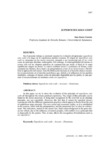Superficies solo cedit

Ver/
Use este enlace para citar
http://hdl.handle.net/2183/7433Coleccións
Metadatos
Mostrar o rexistro completo do ítemTítulo
Superficies solo ceditAutor(es)
Data
2008Cita bibliográfica
Anuario da Facultade de Dereito da Univesidade da Coruña, 2008, 12: 1007-1015. ISSN: 1138-039X
Resumo
[Resumen] En el presente trabajo se pretende mostrar la evolución del principio superficies
solo cedit a lo largo de la experiencia jurídica romana. El origen de superficies solo
cedit se encuentra en los mores maiorum, pasando a ser reconocido por el ius civile
como un principio absoluto, inderogable. Sin embargo, la inderogabilidad del mismo se
aviene mal con las distintas prácticas de construcción que desde el final de la etapa
republicana surgen en Roma. La nueva realidad social y económica de Roma, como
constatan las fuentes, lleva tanto a la jurisprudencia como al ius honorarium a flexibi-
lizar la aplicación del mismo. Esta flexibilización iniciada en el derecho clásico encuen-
tra reconocimiento en el derecho postclásico que, debido a la influencia de los pueblos
orientales, consagra el mismo como un principio disponible por las partes, lo que per-
mite el reconocimiento de institutos como ius superficici. [Abstract] In this paper we try to show the evolution of the principle of superficies solo
cedit all throughout the roman juridical experience. The origin of this principle can be
found in the mores maiorum, it being later recognized by the civil law as an absolute
principle, one not repealable. However, the fact that it cannot be repealed doesn’t
correspond with the different construction practices which appear in Rome from the end
of republican stage onwards. The new social and economic reality, as it is established
in the sources, leads both the jurisprudence and the praetorian law to relax its enforce-
ment. The relaxation, started in the classic law, finds acknowledgment in the post clas-
sic law which, due to the influence of eastern peoples, will confirm it as a principle that
is disposable by the parties. This, in turn, allows the recognition of institutions such as
ius superficici.
Palabras chave
Superficies solo cedit
Acessio
Dominium
Acessio
Dominium
ISSN
1138-039X





